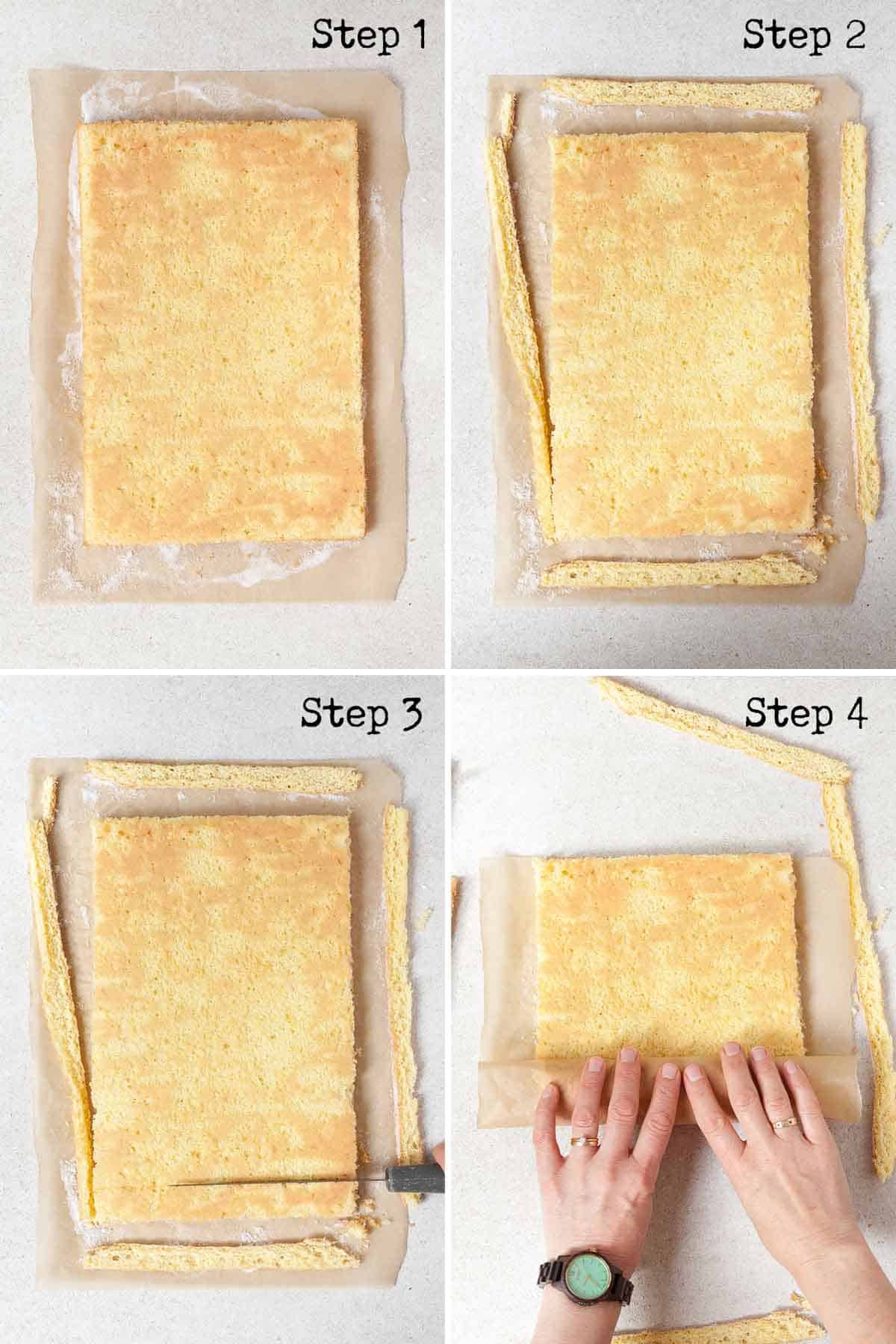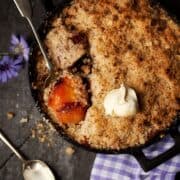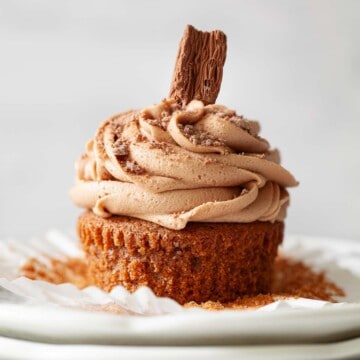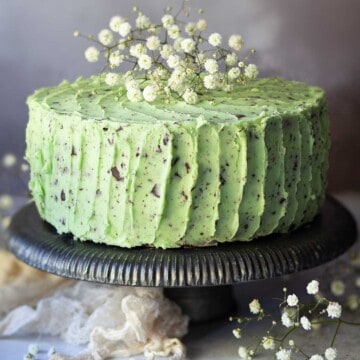Lemon Meringue Cake is the ultimate summer dessert to serve. This lemon swiss roll is filled with summer berries, chunks of meringue and plenty of cream. It’s bound to be a hit but it can also be turned into Eton mess cake very easily.
This recipe was first published in August 2019 and updated in June 2021 with step-by-step instructions expert tips and frequently asked questions.

When I think of summer desserts, my mind immediately focusses on meringue-based concoctions, so I recently decided to make a lemon meringue cake in Swiss roll form.
I was inspired because meringue partners lovingly with just about any summer fruit and of course, fresh whipped cream piled high. The most famous pairing has to be the blend of strawberries, cream and meringue in the much-loved dessert Eton Mess.
But leaving aside the cream, I have fond memories of the fantastic lemon meringue pie my Mum frequently made in the summer when I was a child – it came with an enormous dome of fluffy meringue on top. I’ve never quite got over it.
And so this summery recipe, with two variations, was created.
Why This Lemon Swiss Roll is Worth Making
My lemon meringue cake is really a blend of those two classic desserts – Eton Mess and Lemon Meringue Pie – since I could not decide which one to favour and my homemade jury was not unanimous in their voting. Nestled inside of the lemon Swiss roll is:
- tangy lemon curd
- sweet chunks of meringue
- lashings of cream
- succulent strawberries
- a handful of blueberries
This lemon meringue cake has plenty of summer vibes going on. And it can easily be turned into a straight Eton mess cake by leaving the lemon zest out, replacing the lemon curd with strawberry jam and adding a few more strawberries in place of the blueberries.
Both versions are delicious and won’t hang about for long on your dessert table.

What’s the difference between Swiss Roll & Roulade?
Whilst compiling this recipe I came across a very important question – am I making a Swiss roll or am I making a roulade? That proved to be a good question – here’s the difference between the two:
- a Swiss roll is a cylindrical cake made from a flat sponge cake (often fatless). It is usually filled with jam (and sometimes cream) and rolled up to create a spiral in the cross-section
- A roulade, however, is any dish – sweet or savoury – that has been rolled. So, technically, sushi or beef olives count as roulades
Of course, when I think of a sweet roulade, I think of rolled meringue and flourless cakes. They sound so much fancier than a Swiss roll, but in reality, a Swiss roll is also a roulade. Just not vice versa. So it seems that Swiss roll is special.
So, to be absolutely clear, this lemon meringue cake is a rather fancy Swiss roll.
Which Way Should a Swiss Roll be Rolled?
The hardest part of making a Swiss roll is trying to visualise which way to roll it up. I could never quite work this out when I was a younger baker. In truth, either way will work, but rolling from the short edge will give much more impressive spirals.
Ingredients

Note that lemon Swiss roll recipe calls for plain flour and no baking powder. The rise in the sponge is caused solely by the whipped egg whites.
Although instructions are given for making the meringue, if time is in short supply consider using store-bought meringue. Just crumble it up and scatter over the cake before re-rolling.
The sponge cake uses 3 whole eggs and one extra yolk. The additional yolk is there to add richness to the otherwise fatless sponge cake.
The spare egg white that’s left because of the extra yolk needed in the sponge cake gets used up when making the meringue drops. If, however, you are using pre-made meringue you’ll have an egg white left over. Try making a mini-batch of coconut macaroons with it. You’ll get 4 lovely little golden domes and they only take 5 minutes to put together.
Vary the fruit depending on what’s at its prime. Strawberries, blueberries and raspberries are all fantastic in this recipe. But if you’re making the Eton mess cake use just strawberries.
Step by Step Instructions
Full instructions and measurements are given in the printable recipe card at the end of this post.
There are 4 separate stages to making this lemon meringue cake. Here are the details.
Make the Meringue Drops
1. Whisk the egg white, using electric beaters, in a small mixing bowl until peaks form
2. Add the sugar, a teaspoon at a time, continuously beating until all of the sugar is mixed in
3. Spoon into a piping bag fitted with a suitable nozzle and pipe small mounds of meringue onto a baking sheet lined with parchment (aim for ½ – ¾ cm drops)
4. Bake for around 20 minutes until they can be lifted off the parchment easily then let cool to room temperature
Make the Lemon Swiss Roll
1. Whip the eggs and sugar together until the mixture is thick enough to leave a trail when the whisk is lifted out of the bowl
2. Fold sifted flour and the lemon zest in very gently, to preserve those precious air bubbles that have just been whipped in
3. Pour the batter into a Swiss roll tin that has been greased (sides and bottom) and lined (bottom only) with baking parchment. Ensure that the batter is spread evenly in the tin and reaches the corners
4. Bake for 10-12 minutes until golden and firm
Roll the Sponge Cake Up
This can be a challenge but the secret to success is preparation and working quickly. Aim to roll the cake up whilst it is still warm since you will achieve a better roll this way:
1. Before the cake comes out of the oven prepare your worktop with a sheet of baking parchment dredged with caster sugar, then, as soon as the cake is baked run a sharp knife around the edge of the baking tin to loosen the cake and swiftly invert the tin over the parchment
2. Remove the tin and peel the parchment from the cake and neatly trim the sides of the cake to remove any hard edges. This will help the cake to roll better
3. Score the cake 1.5 cm in along the short edge (see image) – do not cut all the way through. This score helps the cake roll into a tighter spiral
4. Starting at the end you have just scored, roll up the cake into a tight spiral, using the parchment to help you. Set aside to cool completely on a wire rack

Filling the Cake
1. Once cool, unroll the cake, remove the parchment and spread with lemon curd and whipped cream
2. Scatter meringue pieces and fresh fruit over the top and roll the cake back up
3. Finally, decorate as desired and eat within 24 hours. Since the sponge for this Lemon Meringue cake is fat-free it does not have a long shelf life.
Expert Tips
- For a light and airy sponge keep whisking the egg and sugar mixture until the ribbon stage is reached. This is when the batter is thick enough to leave a trail that remains visible for at least 3 seconds before it disappears back into the rest of the batter
- Cook your cake until is is just ready. It should be golden on top and bounce back when pressed lightly with a finger. Avoid over or under-baking:
- Underbaking leads to a dense and heavy cake
- Overbaking causes the cake to crack when rolled
- Be prepared for when the cake comes out of the oven (lay out parchment & sprinkle with sugar) then work quickly once the cake is out of the oven. It rolls up best when still quite warm
- Make sure the cake is completely cold before filling. Whipped cream will collapse if it comes into contact with warmth and the cake will be ruined
- It’s up to you whether to make your own meringue drops (recipe included) or to use store-bought meringues crumbled into pieces. Either are perfectly acceptable
- It’s tempting to be over-generous when filling this cake, but do show restraint as an overfilled cake will not re-roll well
- If your cake does crack during rolling this can be covered by piping cream over them when decorating the cake
- The recipe card includes notes on how to turn this recipe into an Eton mess cake
Frequently Asked Questions
Once assembled this cake should either be consumed within 1-2 hours or covered and refrigerated for later. Let it come back to room temperature for an hour before eating though, to let the flavours fully sparkle.
This cake will go stale quite quickly as it is a fatless sponge recipe. For this reason it is best made on the day it is needed and should be eaten within 24 hours.
Although it is possible to freeze this cake the texture of the fresh fruit will soften and emit liquid once defrosted. For this reason, I recommend eating this lemon Swiss roll fresh.
There are 2 reasons why the cake might crack. Either it was over-baked or it was allowed to cool too much before it was rolled.
To avoid these pitfalls, take care to cook your cake until just baked and work quickly to roll it up as soon as it comes out of the oven.
If your cake does not have a light and bouncy texture, it’s likely that the batter was over-mixed once the flour was added. The flour should always be folded in very gently, using a large metal spoon, until only just mixed in.
If you are certain the batter was not over-worked the alternative reason for a heavy sponge is that the cake was underbaked.

More Summer Desserts to get Tempted by:




Have you been tempted by this lemon meringue cake? Or did you turn it into an Eton mess cake? If you make either I would love to see – just upload a snap onto on Instagram and tag #littlesugarsnaps so I can see it too. And please leave a comment and/or rating belong so I can see how you got along.

Lemon meringue cake
Equipment
- 1 Swiss Roll tin (20cm x 30cm)
Ingredients
For the Meringue drops
- 60 g/ 2 oz Caster sugar
- 1 Egg white – large, free-range
For the Cake
- 75 g/ ⅓ cup Caster sugar
- 100 g/ ¾ cup Plain (all-purpose) flour
- 3 Eggs – large, free-range
- 1 Egg yolk – large, free-range
- Zest of a lemon
For the Filling & Decoration
- 4 tablespoon Lemon curd
- 250 ml/ 1 cup Double (heavy) cream
- 24 Blueberries
- 3 Strawberries
Instructions
Make the Meringue Drops
- Preheat the oven to 110C/ 225F/ GM ¼ and line a baking sheet with parchment
- Whisk the egg white, using electric beaters, in a small mixing bowl until peaks form
- Add the sugar, a teaspoon at a time, continuously beating until all of the sugar is mixed in
- Spoon into a piping bag fitted with a suitable nozzle and pipe small mounds of meringue onto the parchment (aim for ½ – ¾ cm drops)
- Bake for 20 minutes and try to lift a few drops off the parchment. If they peel away easily, the meringues are sufficiently cooked and can come out of the oven. If not, continue to bake for another 10 minutes and try again
- Once baked, let cool to room temperature
Make the Swiss Roll
- Preheat oven to 180C/ 350F /GM 4. Grease the base and sides of a 20 x 30cm Swiss roll tin and line the base with baking parchment. Do not line the sides
- Put the eggs and yolk plus the sugar into the bowl of a stand mixer and whisk for around 5 minutes until pale & thick enough to leave a trail when a spoonful is lifted out of the bowl and drizzled back in (the ribbon stage)
- Sift the flour and fold half into the batter using a metal spoon. Fold the remaining flour in, along with the lemon zest. Take care to fold in the flour very gently, so the air whipped in previously is not knocked out
- Pour into the baking tin, spread out evenly and cook for 10-12 minutes until the sponge is golden and firm. Overbaking the sponge will increase the risk of the cake breaking up, so keep a close eye on the cake as it bakes
- Meanwhile, lay a sheet of parchment onto a worktop and sprinkle with 1-2 tablespoon caster sugar
- Working quickly, when the cake is baked remove it from the oven, run a sharp knife around the edges of the tin to loosen the cake and then immediately invert the tin over the parchment. The cake should come out of the tin easily
- Remove the parchment used to line the tin from the back of the cake and trim the edges of the cake to neaten
- Score a line across the short edge of the cake about 1.5 cm in (do not cut right through the cake though) – this will help the cake to roll
- While the sponge is still warm (but not piping hot), roll the cake up into a tight spiral – use the parchment to help (the parchment will roll into the spiral of cake as you roll the cake). Let it cool completely on a wire rack
Filling the Cake
- Reserve 4 blueberries and 1 strawberry (quartered) for decoration
- Whip the cream until it holds its shape in firm peaks
- Unroll the cake and spread the lemon curd over the base
- Top with ⅓ – ½ of the cream and spread it out (don't overfill the cake or it will be difficult to re-roll
- Dot meringue drops over the cake along with the remaining blueberries and the strawberries (chopped)
- Carefully re-roll the cake and place seam down on a serving plate
- Pipe the remaining cream onto the top and use the reserved fruit to decorate
- Serve straight away or store in the fridge until ready to serve (allow to sit at room temperature for 1 hour before serving)
- Best eaten within 24 hours
Notes
How to Convert to an Eton Mess Cake
- Omit the lemon zest from the cake batter. Add 1tsp vanilla extract in its place
- Use strawberry jam in place of lemon curd
- Replace the blueberries with 2-3 extra strawberries
Expert Tips
- For a light and airy sponge keep whisking the egg and sugar mixture until the ribbon stage is reached. This is when the batter is thick enough to leave a trail that remains visible for at least 3 seconds before it disappears back into the rest of the batter
- Cook your cake until it is just ready. It should be golden on top and bounce back when pressed lightly with a finger. Avoid over or under-baking:
- Underbaking leads to a dense and heavy cake
- Overbaking causes the cake to crack when rolled
- Be prepared for when the cake comes out of the oven (lay out parchment & sprinkle with sugar) then work quickly once the cake is out of the oven. It rolls up best when still quite hot
- Make sure the cake is completely cold before filling. Whipped cream will collapse if it comes into contact with warmth and the cake will be ruined
- It’s up to you whether to make your own meringue drops (recipe included) or to use store-bought meringues crumbled into pieces. Either are perfectly acceptable
- It’s tempting to be over-generous when filling this cake, but do show restraint as an overfilled cake will not re-roll well
- If your cake does crack during rolling these can be covered by piping cream over them when decorating the cake







Kathryn
This sounds so good. It would be perfect for a late summer or early fall party! Saving for later!!
Jennifer
What a delicious swiss roll! It was absolutely delightful, and looks lovely on the table as well. I’m glad you included the instructions for an Eton Mess roll too! That’s another family favorite.